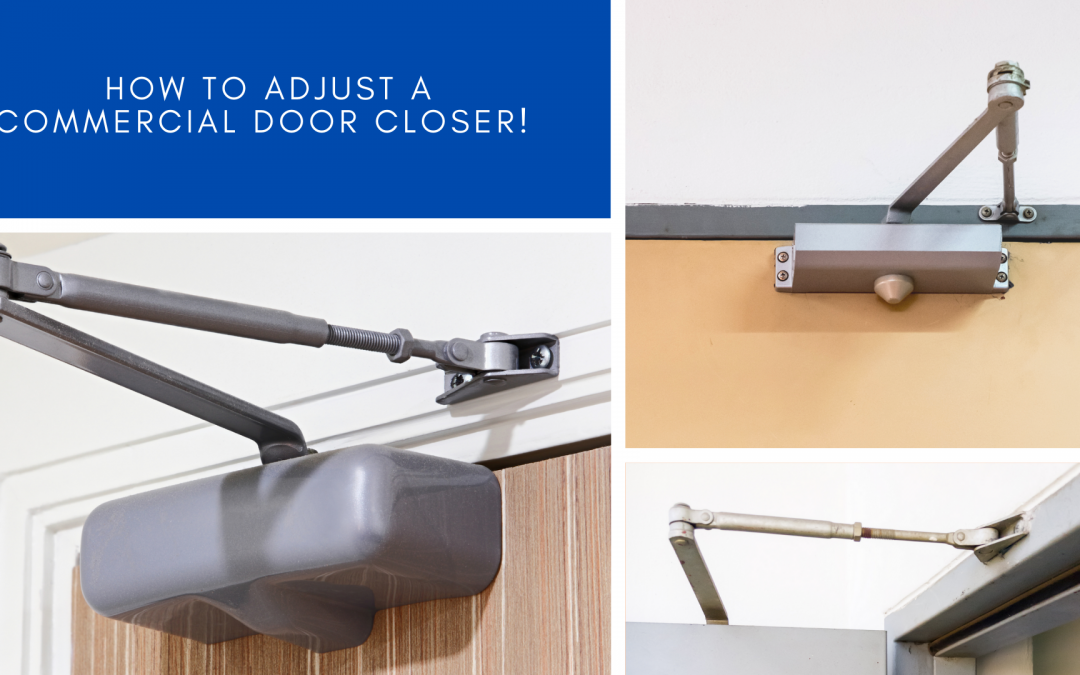Most commercial buildings all across the world have commercial door closers installed. These closers regulate how fast a door closes when it is in use. However, a commercial door closer can get misaligned over time, resulting in higher energy expenses, maintenance costs, and possibly unsafe circumstances.
How to Adjust a Commercial Door Closer
Periodically checking and adjusting a door closer is a great way to save money on energy expenses. That is especially helpful when you own an older establishment or building. You can properly adjust your door closers with the right tool for the job. Learn how to adjust a business door closer with a commercial door locksmith from MacArthur Locks & Doors.
STEP 1: Remove the cover
If there are no adjustment screws visible, the closer most likely has a cover. The cover is often made of plastic; however, it can alternatively be made of metal. If there are no fasteners keeping the cover in place, then it is held in place by tension. Lift it off, and if fasteners are visible, loosen but do not remove them. The cover should slide off.
STEP 2: Adjust all the hydraulic valves
There are three adjustable hydraulic valves on most basic closers that function together to assist the door in closing seamlessly: the backcheck, the sweep/main speed, and the latching speed. Turn the three hydraulic valves clockwise until they come to a halt.
How to adjust the backcheck
First, open the door 1.25-1.5 turns counterclockwise and ensure it comes to a steady, forceful stop. The door should begin slowing down at about 75 degrees to avoid slamming into the floor behind it or getting caught in the wind. Then, the door will open further if you turn the valve counterclockwise.
How to adjust the sweep/main speed
Adjust the door’s closing speed by turning it 1.5-2 turns counterclockwise. The closing speed is slowed by turning the valve clockwise.
How to adjust the latching speed
Turn the knob 1.5-2 times counterclockwise to get the appropriate latching speed. The environment determines the proper latch speed. If the door is on the outside, you should raise the latch speed (counterclockwise) so it closes more quickly. If it is an interior door, do it slowly (clockwise) to avoid slamming it shut.
STEP 3: Test the door
Open and shut the door several times to check the adjustments and make any necessary changes. Remember that minor modifications can have a large effect; even an eighth of a turn can make a massive difference. For example, reduce the speed of the closer by turning the valves clockwise, and raise the speed by turning them counterclockwise.
When Is It Time To Replace Your Commercial Door Closer?
Do not proceed with the adjustment if you notice oil in the cover or oil on or oozing from the closer body. Instead, contact a commercial door repair service as you will need a new door closer.
If your door closer is closing the door and you cannot get it to open any other way, it means the fluid has leaked, or the valve seals have worn out. In either scenario, it is best to have a local commercial door Bethesda MD technician replace it.
Likewise, if the spring tension adjustment on the door closer revolves around with no result, the spring is broken, and the door closer must be changed by a commercial door Washington DC expert.
Locksmith Services Near Me
Do you have the correct door closer? At MacArthur Locks & Doors, we can assist you in determining the best option for your door opening. We provide excellent locksmith Washington DC services to residential and commercial clients in the DMV area. We are available for any type of locksmith service, including commercial door repair and commercial door installation. Call us today at (202) 760-4589.
